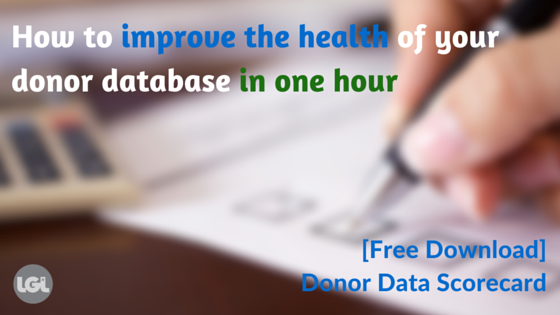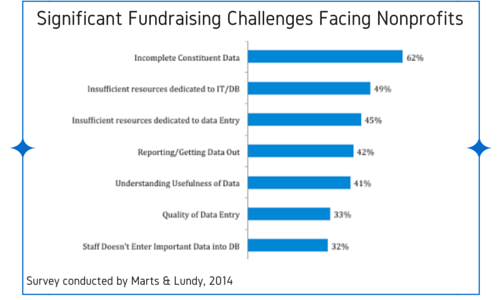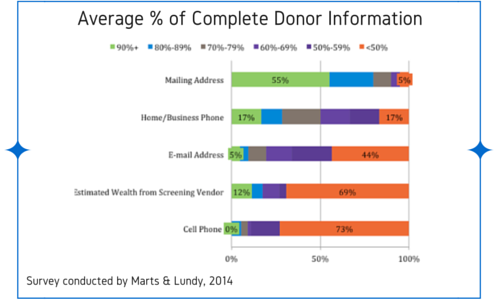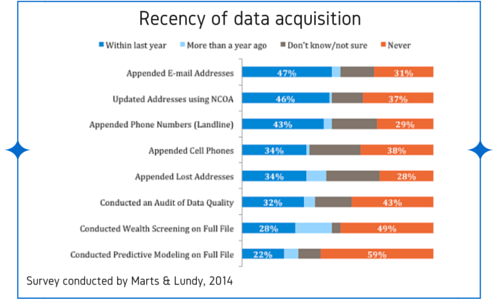Little Green Light is a cloud-based donor management system for fundraisers.
Subscribe to get our latest product updates, best practices and tips to grow your nonprofit.

One of the greatest challenges facing nonprofit fundraisers is incomplete or unorganized donor data. You can improve the health of your donor database by performing a donor database audit. Not sure if you need to?
Consider this scenario: You’re tasked with raising some much needed revenue for your nonprofit, and you’re excited to get started! You’ve drafted a great plan of action and produced some excellent materials that tell a compelling story about your organization and its mission, and you’re ready to get rolling. There’s just one thing…it’s been awhile since you reached out to your organization’s supporters and you’re not sure how reliable your data is.
Think you’re alone? You’re not! One of the biggest struggles facing nonprofits today is incomplete or unorganized donor data. According to a survey of Marts & Lundy and Little Green Light clients in 2014 (survey conducted by Marts & Lundy) over 62% of respondents indicated that their biggest fundraising challenge was incomplete constituent data.

As a matter of fact, when nonprofits in the same study were asked about what percentage of their donor database contained basic contact information, only 55% said they had accurate mailing addresses on 90% or more of their constituents. Phone and email data dropped significantly from there.

And, only 32% of respondents had done a data quality audit within the last year:

Given those responses, rest assured – you are not alone in your data conundrum. But, with a little bit of planning and a few pointers, you can identify areas in your database needing improvement in as little as an hour! Here’s how…
How to assess your database health
Here at LGL, we’ve created a Donor Data Score Card that you can use to assess the health of your donor database and identify where improvements are needed.
Using the LGL Donor Data Scorecard to perform a donor database audit
Step 1:
Select 25 or so constituent records from your database that are most important and/or well known to your organization.
Why 25 records?
You should be able to see some correlation between the records you are most familiar with and the rest of your database. For instance, if you have inaccurate information for 30% of your most involved and engaged constituents, it’s likely you’ll have at least that many inaccuracies (if not more) in your overall database. Given that this is a “quick spot check,” looking at just 25 records to start with can be a lot less daunting than facing your entire database.
Note: Once you’ve assessed the first 25 records, you can expand your review and select other segments or groupings if you want to, i.e., lapsed donors, recent members or volunteers, and so on.
Step 2:
Do a quick Spot Audit of those records and determine the percentage of records that have correct contact information, clear and accurate constituent coding, and gift recording. A score of 80% or higher is preferred.
What types of information should I review in the Spot Audit?
There are 3 types of data that we consider important to include in your Spot Audit: Contact information, constituent coding, and gift history.
Contact Information: Be sure you review the name information in your database, and confirm that the addressee and salutation fields are accurate as well. Is the constituent married? Is their spouse name in the record? Do you have complete address, phone, and email data for each record?
Constituent coding: Are the records properly coded with their relationship to your organization? Can you identify if this is an individual or organizational record? Are records properly marked as deceased?
Gift history: Are gifts accurately recorded with soft credits posted as appropriate? Are pledges present and clearly indicated as such?
Step 3:
Assess your organization’s data strategy and maintenance practices, and assign a point for each question you are able to answer in the affirmative. A cumulative score higher than 10 is preferred.
What types of information should I review regarding Strategy and Maintenance?
We suggest considering these categories of data: Prospecting, coding strategy, contact information maintenance, general maintenance, and reporting.
Give yourself a point for each bullet you answered with “yes”:
Prospecting:
Have you performed a wealth screening within the last 24 months?
Does your organization complete a routine review of prospects? (Note: Routine might mean different things to different organizations. The point here is that you have a routine that you follow.)
Have you held a top prospect rating meeting within the last 12 months?
Coding strategy:
Do you segment your appeals/solicitations?
Do you track event attendance?
Do you regularly review the records of your organization’s lapsed donors?
Contact information maintenance:
Have you had an NCOA Service performed within the last 12 months?
Have you ever used a data append service to update your constituent records?
Do you use an address verification service (i.e., SmartyStreets)?
General maintenance:
Does your organization have a written policy on deleting records?
Has your organization completed a data review in the last 12 months (i.e., checked for duplicates, ensured proper gift coding, etc.)
Does your organization have written procedures for handling deceased constituents?
Reporting – Does your organization have the ability to run the following:
LYBUNT/SYBUNT report (lapsed donors and long lapsed donors)
Top donor reports
Donor retention reports
Mailhouse-ready reports (which you’d need to run to send to your printer for a large mailing)
That’s it! The donor database audit is complete and it’s time to total up your Score Card. Review your scores and identify your database strengths to learn where improvement is needed. Once the problem areas have been identified, you can work up a plan to fix them before your next outreach effort.
We’ve created the LGL Donor Database Score Card, a template you can use to assess the health of your donor database and perform a donor database audit. Click on the image below to request your free copy:
Ready to try LGL? Get your first 30 days free. No credit card required.